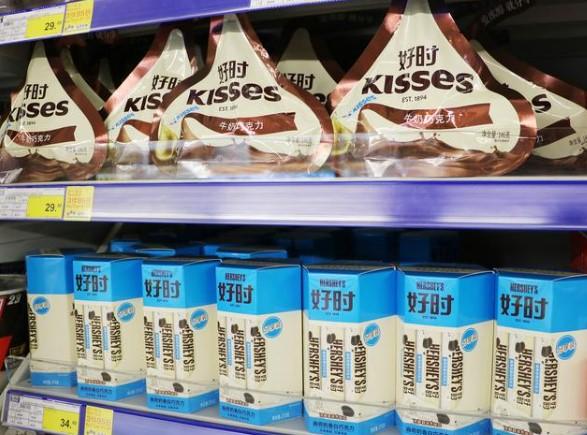“Information about (Hershey’s) withdrawals and store closures is not true, China has always been one of the important markets for Hershey’s, and Hershey’s is optimizing its sales channel model in China.” On February 11, in response to the rumors that the Chinese market will be launched, the chocolate giant Hershey, which has more than 100 years of brand history, said in an interview.
Hershey’s was once known to consumers by the advertising slogan “big taste in a small body”, as the largest chocolate and chocolate confectionery manufacturer in North America, the brand’s business entity in China was established in April 2001 in Shanghai, China, the legal representative is ROHIT GROVER, registered capital of about $83,900,000, by (Hershey International LLC) wholly owned by the United States.
On February 11, the reporter searched for Hershey’s official online stores through keywords such as “Hershey” and “Hershey flagship store” on Tmall, Taobao and JD platforms respectively. However, Tmall and Taobao did not show its official flagship store, although Hershey’s own store in JD still has some goods on sale, there are more than ten categories of products that are out of stock.
Hershey denies withdrawing from the Chinese market
The rumors that Hershey’s wants to withdraw from China, many Chinese netizens recall the once familiar chocolate does seem to be increasingly “hard to find its trace”.
Previously, the internal staff of the Hershey Dessert Store said in an interview that Hershey has started laying off staff in Shanghai, China since 2020, and has reduced its business in the Chinese market. In May 2021, a letter was suddenly sent to inform Hershey Dessert. The store demanded that the contract be terminated.
In late January 2022, Hershey’s Dessert Concept published a tweet on its WeChat subscription number, indicating that Hershey’s intended to reduce its headcount and adjust the size of its China market as it adjusted its development strategy in mainland China. The original Hershey chocolate distributors from Beijing, Shanghai, Guangzhou, Shenzhen and other places have revealed that Hershey has quietly evacuated from its office in Xinmei Union Square, Pudong New Area, Shanghai. In addition, Hershey’s handling of channel legacy issues has caused great dissatisfaction among dealers.
“Hershey’s Beijing East self-owned store shortage is due to the Spring Festival period product sales surge, resulting in short supply, the company is currently working with dealers to solve the supply problem, the follow-up goods will follow one after another; Hershey’s Tmall flagship is being redecorated, the new official flagship store is expected to be online at the end of February.” According to Hershey’s statement to the reporter, in the future, Hershey will adopt a new business model, and further optimize the production model, from domestic production to import production, enrich the product line of Hershey’s China market, expand the baking category, snacks market, and the emerging restaurant channels for in-depth cooperation, to meet the localized needs of Chinese consumers.
Market positioning is said to be unclear
According to public information, as the largest chocolate and chocolate candy manufacturer in North America, Hershey’s, KISSES, Hershey On10 and other brands are owned by Hershey Company. As early as 1923, Hershey’s chocolate had entered the Chinese mainland and Hong Kong, Macao and Taiwan market, and China can be said to have a deep origin. In 1995, Hershey’s entered the Chinese market. In September 2014, the company acquired the Chinese local brand Golden Monkey at lightning-quick speed, which was the first food company acquired by Hershey in the 19 years since it entered the Chinese market. However, after the “sweet” period between the two sides lasted for 4 years, they finally chose to break up.
However, from the perspective of performance, Hershey’s performance in the Chinese market is not satisfactory, declining for many years. In 2018, Hershey’s net sales were US$7.791 billion, a year-on-year increase of 3.7%, while the Chinese market fell by 20.5%; in 2019, Hershey’s revenue was US$7.986 billion, a year-on-year increase of 2.5%, while the Chinese market fell by 13.4% year-on-year; in 2020, Hershey’s global net sales were approximately US$8.15 billion, a year-on-year increase of 2%. Sales in the Chinese market fell 46%, of which the fourth quarter fell by 82.2%.
Not only is the performance declining, but Hershey’s market share in China is also facing considerable challenges. According to Euromonitor’s market data, in the Chinese chocolate market in 2020, Hershey’s market share is only 3.2%, far lower than Mars’ 32.8%, Ferrero’s 22.3%, Nestle’s 8.3%, and Pladis’ 3.5%, ranking fifth.
On February 11, the reporter visited a large and well-known business in Shanghai’s Pudong New Area and found that there were no Hershey chocolates on the dazzling chocolate shelves. According to the salesperson, the supermarket’s top chocolate sales are Lindt, Gottivan and other brands. “Hershey chocolates are not on the shelves.”
According to Zhu Danpeng, an analyst in China’s food industry, Hershey’s sales business in the Chinese market has declined. In addition to the impact of the epidemic, the more important reason is its embarrassing market positioning. Different from Hershey’s “bumpy” operation, candy brands such as Ferrero, Mars Wrigley, and Mondelez are developing strongly in the Chinese market. New chocolate brands such as Daily Heiqiao have frequently received financing, and Hershey’s market is facing a squeeze.
“Hershey Chocolate is difficult to follow the trend in the e-commerce era (2015-2010). Although it has been trying hard to transform and try, it has always been a passive transformation, so it has missed Internet marketing and e-commerce bonus opportunities.” Famous top-level design expert, Sun Wei, a senior researcher in brand marketing at Tsinghua University, told the reporter that Hershey’s management model is still an offline channel model, and it lacks effective use of e-commerce operations, omni-channel marketing and content marketing, resulting in a gradual decline of brands and sales. “The pandemic of the past two years has prompted its profit overdraft and losses, so it has to liquidate the company, but this does not mean that Hershey Chocolate will withdraw from China.” Source
